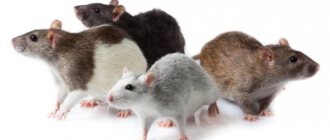- home
- Rat
- Good to know
06/21/2019 Rats, although they belong to rodents, are still quite different from most representatives of this order. Among the distinctive features of these animals, which are very common as pets, it is worth highlighting their high intellectual abilities, intelligence and cunning. But that's not all - as scientists have found, rats can laugh and this especially strongly emphasizes their uniqueness. Of all the living creatures living on the planet, only humans and rats are able to laugh consciously. The ability of rodents not only to have fun, but also to laugh at the same time, like humans, is probably due to the fact that the human and rat genomes coincide by 95%.
Reasons why a rat laughs
As scientists have established, rats (both decorative and wild) are the only animals that, along with humans, are capable of consciously laughing. Researchers associate this feature with a high level of intelligence and socialization of rodents. Most scientists are inclined to believe that the cognitive abilities of rats are superior to those of domestic cats and dogs. Usually little furries laugh for the following reasons:
- tickling – the skin of decorative rats is susceptible to light touches;
- playing with relatives - rats are social animals, so active spending time with their cagemates brings only positive emotions to them;
- family idyll - female rats are considered one of the most caring mothers in the animal world, they are very kind to their little rats, so during periods of special tenderness you can notice a smile on the face of the new mother.
In general, rats, like people, can laugh and smile, experiencing any positive emotions. For example, rodents are known to laugh every time they receive their favorite treat.
The laughter of male rats makes them more attractive to females. It has been established that rat girls choose smiling, cheerful gentlemen for procreation.
Fake laughter
Sometimes people laugh to avoid showing their true feelings, and sometimes out of politeness. We actually often use fake laughter, but it is not always possible to deceive the interlocutor or others. In 2022, it was proven that absolutely all cultures can recognize real laughter. Researchers proved this with the help of eight hundred volunteers from twenty countries. The participants were shown recordings of spontaneous and simulated laughter, with people of one nation listening to people of another. Japanese listeners were the most accurate, guessing true laughter seventy percent of the time.
How to make a rat laugh
A pet's smile undoubtedly evokes the most positive emotions in the owner. So it's no surprise that rodent owners are constantly looking for ways to make their pets laugh. The following actions will help you make a decorative rat laugh:
- The surest way is to tickle the fluffy . You just need to act as carefully as possible so as not to hurt the animal. Each rat has its own most sensitive areas. Therefore, you will first have to “probe” the vulnerable spots. These can be the pads of the paws, belly, sides, area under the neck, withers.
- Give your pet a fun time . The best thing to do is let the rat out of the cage and play with it a little. For example, use your hand as an imaginary opponent, alternately retreat under the onslaught of the rodent and attack, while lightly tickling the “prey”.
- Buy a same-sex companion for your pet . Rats living alone feel very bad. Therefore, it is better to populate a cage with 2-3 individuals at a time. Then the pets will have fun frolicking and playing, making each other laugh. The owner will only have to watch the pets and their smiles.
Each rat has its own individual character. Therefore, you need to watch your pet a little. Some rodents may laugh while walking in the fresh air, others - when listening to certain tunes, and others - when receiving their favorite treat. The main thing is to be attentive and notice under what circumstances the pet’s face breaks into a satisfied smile.
It should be taken into account that in a stressful situation or if there is danger nearby (a cat or a stranger), the rat will not laugh. None of the above methods can make her laugh. This is due to the instinct of self-preservation - as long as the pet feels any threat to its life, it will not have fun.
It is worth noting that the human ear is not able to recognize the laughter of rats. You can tell that your pet is having fun by the contented smile on the animal’s face, as well as by its cheerful squeaking or grunting.
The animal’s ears can also tell about the high spirits and laughter of a decorative rat. The fact is that while laughing, the pet’s blood begins to circulate more actively. As a result, the rat's ears turn red, become limp, and take on a drooping appearance.
Rats laugh much more often than adults. And this is not surprising - like any children, they love to play and frolic.
Immunity
A 2003 study sought to determine the effect of laughter on the activity of NK cells, which play a major role in immunity. Researchers conducted an experiment with 33 healthy adult women who were shown a comedy video. The dependence of NK cell activity on how funny the video was presented to the subjects was established. The funnier the subject was, the more actively the cells responsible for immunity worked.
Just look at their faces! It seems these dogs were people in a past life
Lifehack “1000 hours outside the home”: it works wonders for people’s health and psyche
Volunteers from France will spend 40 days in a cave without electricity or smartphones
What other emotions does a rat have?
Rats are capable of experiencing a whole range of emotions, and each of them corresponds to a separate sound signal. Each owner needs to study the emotional reactions of the pet, this will help to quickly establish a close connection with the animal. Basic emotions of rats:
- Fear - the rat screams heart-rendingly loudly in a chesty voice. In this case, the animal hides in a corner or hides in a house. To calm the animal, you simply need to remove the irritating factor. For example, turn the music down, kick the cat out of the room, remove a new toy from the cage.
- Discomfort or pain – the pet squeals, squeaks, or chatters its teeth. At the same time, the rat becomes quiet, lethargic and apathetic. In such a situation, it is necessary to show the animal to a veterinarian. Most likely the pet is sick.
- Aggression - the rat hisses like a cat, makes wheezing sounds, and chatters its teeth. At the same time, the pet’s fur stands on end, and the fluffy himself takes a warlike pose. At such moments, it is better not to approach the fluffy one or even leave him alone. If there are other rats in the cage, it is better to put them away for a while - the possibility of an attack cannot be ruled out.
- Pleasure, high spirits - the rat grinds its teeth or squeaks quietly. At the same time, the pet clearly demonstrates its readiness to communicate - it sniffs the owner’s hands, approaches the cage door, and flirts with other rats.
- Sympathy for the opposite sex - potential partners make vibrating sounds (like a cat purring). At the same time, the animals actively show mutual interest - they sniff each other, engage in grooming, and play.
Knowing why a rat smiles and laughs, every owner will be able to build a close emotional connection with their pet. After all, small animals feel when the owner is trying to make them laugh or please. A grateful pet, in turn, will definitely respond to the person with sincere love and trust.
Sounds of communication
When expressing feelings and mood vocally, the tonality and nature of the sounds produced by a rodent are diverse. For example, by squealing or chirping, your pet shows that it is scared or feels discomfort. Hissing expresses hostility and aggression. If your pet starts hissing, it is better not to disturb him. He is capable of biting the owner, moreover, this negatively affects the state of his nervous system. The animal will refuse food and may even bite its cage neighbors.
If the little tailed friend is in a good mood, then the new owner, who has previously had no experience in handling decorative rodents, will be able to personally see in practice whether the rats are laughing. Laughter will be an expression of delight and joy from communicating with a person or relatives: characteristic sounds - the pet will squeak or grunt a little.
Bone tissue injuries
The most common injury is a broken tail in a rat, which occurs as a result of being pinched by a cage door. It is not uncommon for owners or family members to unintentionally step on a rodent.
Veterinarians are confident that if a rat breaks its tail and is examined by a specialist in time, breeders can rest assured. Typically, the broken part must be amputated, but in rare cases the animal may chew it off. If a wound is found on the tail, the area is treated with a weak solution of potassium permanganate.
If the owner accidentally steps on a rat and the animal is injured, it is important to act quickly:
- place the animal on a flat surface;
- if a rodent has broken its spine, it will drag its hind legs;
- when an animal drags one paw, then we are talking about a fracture of the limb.
The exact type of damage is only visible on x-rays. If a spinal fracture is suspected in a rat, the rodent is placed in a small box and covered with cotton wool. If an animal has a broken leg, it is permissible to apply a splint made from a flat stick above the fracture site.
After initial measures, it is necessary to take an x-ray of the rat’s paw fracture so that the doctor can make an accurate diagnosis.
He who is in rat's skin is small, but he is brave
Rats have truly limitless abilities; in particular, they can be excellent laboratory assistants. In Tanzania, these animals detect tuberculosis bacteria. Modern technologies can test no more than 20 saliva samples per day, but rats test 150 samples in a matter of minutes. In the same country, rats search for mines, dynamite, and other explosives.
Photos from open sources
Burmese rats “serve” at customs. They will not let through a single drug courier, not a single drug baggage. A similar practice was adopted in Russia and the USA. have great advantages over dogs, since they instinctively sniff everything around them, and also penetrate into places that are inaccessible to large animals.
Australian biologists tickled rats for a month for the sake of science
Scientists from a laboratory in Canberra tickled experimental rats every day for a month to improve their emotional state. Happy animals perform better during experiments. This means they help people, including seriously ill people. In addition, such interaction helps to establish contact. So that everyone can make friends with rats, biologists have released a special online course on how to tickle them correctly.
Tickling imitates the playful struggle of young rats. While stroking, rodents produce ultrasonic vocalizations, writes The New York Times. The louder the rat squeaks, the more it likes what is happening. At the same time, rodents are just like people - not everyone likes tickling.
“There is a right way and a wrong way to tickle a rat. If you do it wrong, at best the rat will not understand you, and at worst, you will harm it,” said laboratory animal specialist Carly Mottley.
How to tickle a rat correctly
- Touch the back of the rat's neck with a quick, light motion. Stroke the animal's back. Do not touch the tail and buttocks. The aggression of relatives is usually directed at these parts of the body, and the rat may become frightened.
- Gently grab the rat around its front legs, lift it up, and use your wrist to turn it onto its back.
- Tickle the rat's chest and the space between its front legs, constantly pressing it to the surface and leaving no chance to roll over. This interaction accurately imitates playful wrestling and allows the rodent to get maximum pleasure.











